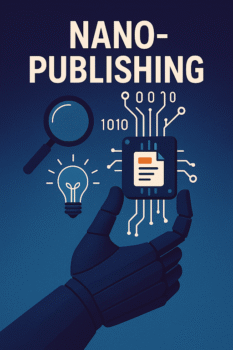The Rise of Short-Form Research in Nano-Publishing
A nanopublication is a small knowledge graph snippet with metadata that is treated as an independent (scientific) publication. This information in a nanopublication can be about anything, for example a relation between a gene and a disease or an opinion. Nanopublications are expressed in a knowledge graph format that is formal and machine-interpretable. With nanopublications, it is possible to disseminate individual data as independent publications with or without an accompanying research article. Furthermore, because nanopublications can be attributed and cited, they provide incentives for researchers to make their data available in standard formats that drive data accessibility and interoperability. Nanopublications have the following general structure:
A nanopublication has three basic elements:
Assertion: The assertion is the main content of a nanopublication in the form of an small atomic unit of information
Provenance: This part describes how the assertion above came to be. This can include the scientific methods that were used to generate the assertion, for example a reference to the kind of study that was performed and its parameters.
Publication Info: This part contains metadata about the nanopublication as a whole, such as when and by whom it was created and the license terms for its reuse.
Reasons for the Rise of Nano-Publishing:
- Rapid Dissemination of Research:
Short-form articles allow researchers to quickly share their findings with a wider audience, enabling faster collaboration and innovation.
- Digital Platforms and Open Access:
Online platforms like Nano Express and Discover Nano facilitate the publication and accessibility of research, making it easier for researchers to share their work.
- Focus on Practical Applications:
The emphasis on real-world applications of nanotechnology, such as in energy storage, medicine, and materials science, encourages researchers to publish shorter, more focused articles that demonstrate the practical impact of their work.
- Improved Review and Publication Processes:
Journals and platforms dedicated to nano-publishing are streamlining the review and publication processes, making it easier for researchers to get their work published quickly.
Benefits of Nano-Publishing:
- Faster Innovation:
Quicker dissemination of research findings leads to faster innovation and development of new technologies.
- Enhanced Collaboration:
Short-form articles facilitate collaboration among researchers by making it easier to share ideas and findings.
- Improved Accessibility:
Online platforms and open access make research more accessible to a wider audience, including researchers, industry professionals, and the public.
- Increased Impact:
Short-form articles can have a greater impact on specific areas of nanoscience and nanotechnology by highlighting key findings and advancements.


